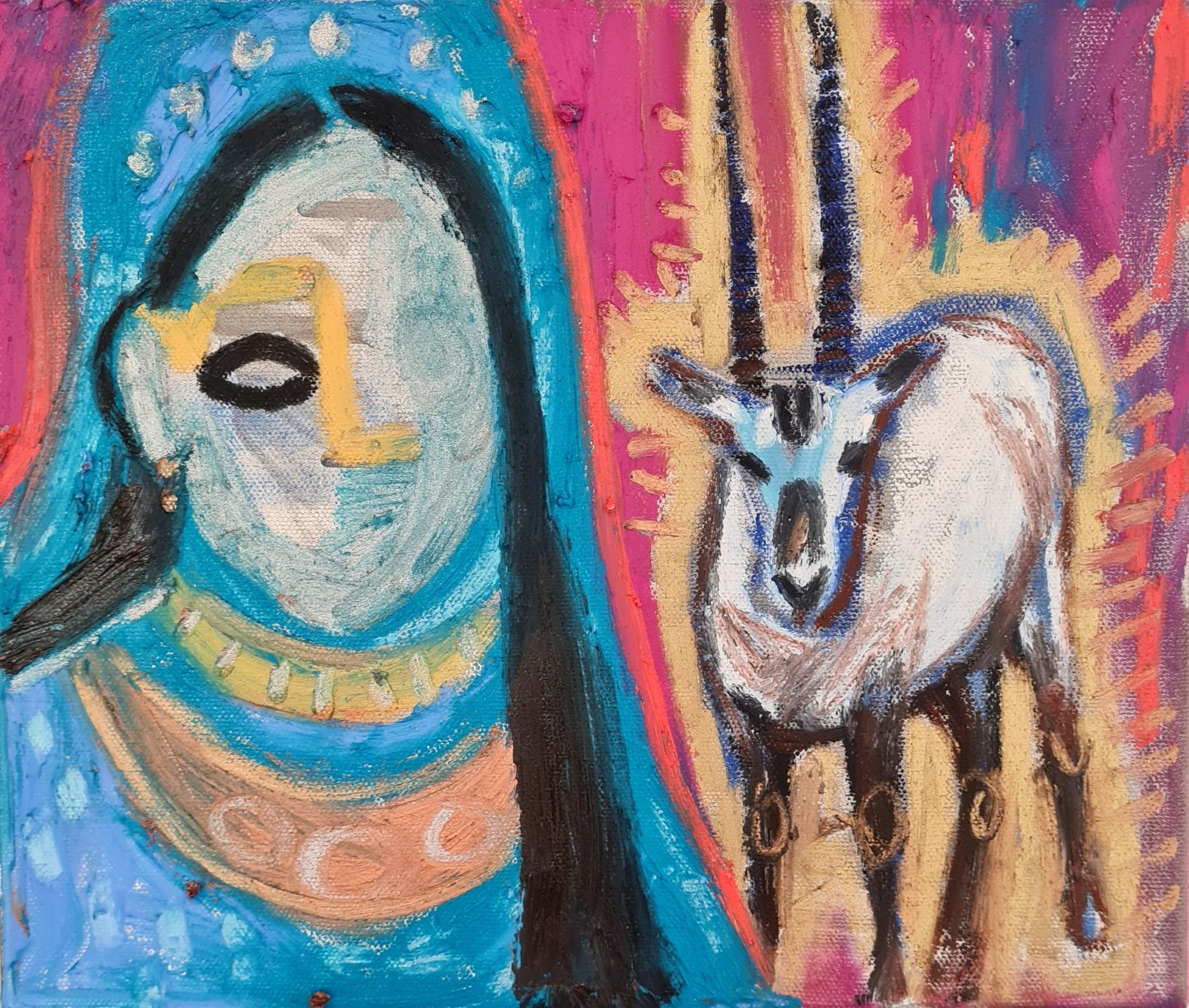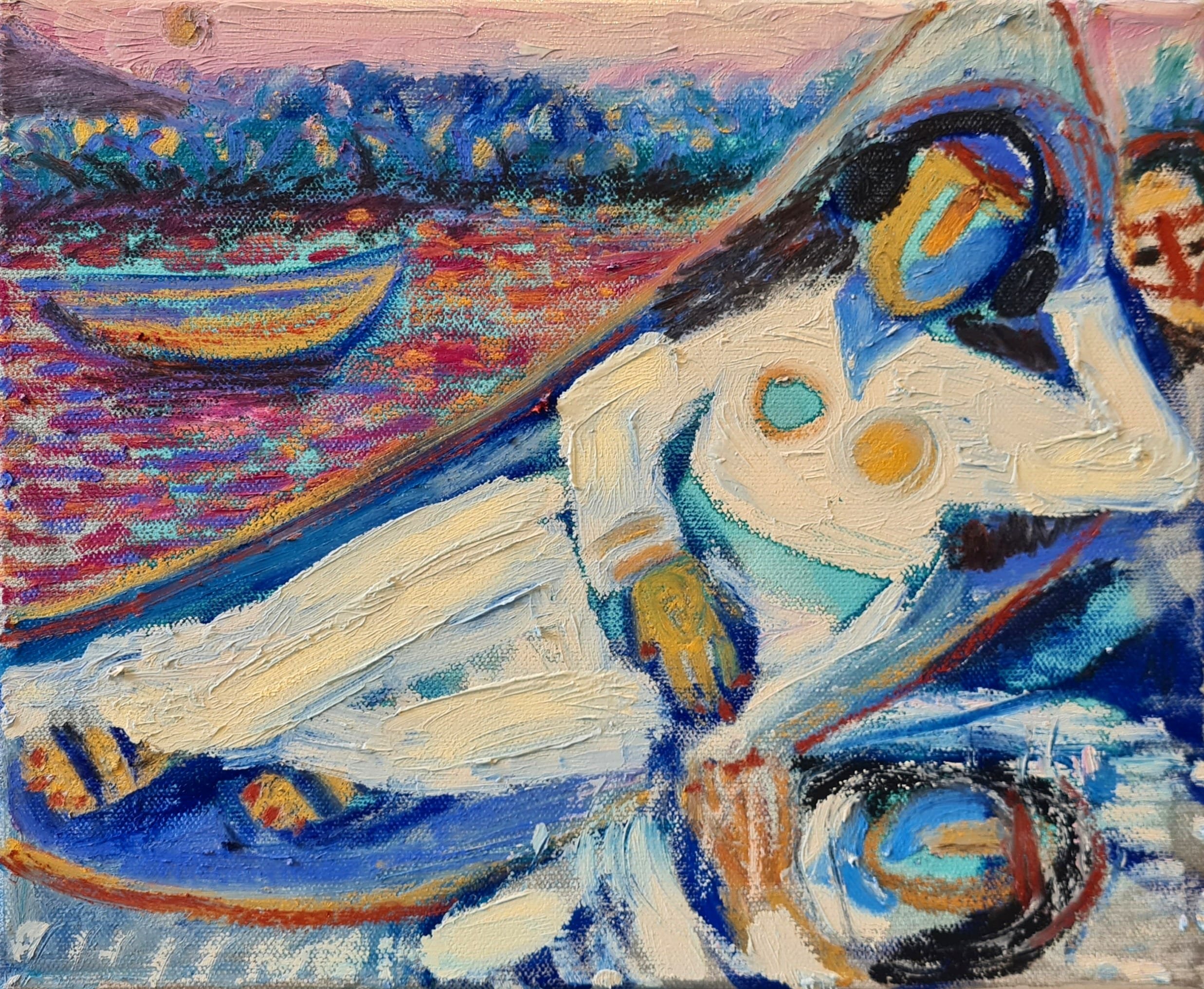10 Questions with Latifah A Stranack
Latifah is an Anglo-Omani artist based in London. She studied at the Royal College of Art for her MA in Visual Communication and then decided to attend the Slade for her MFA. She has a mixed cultural background, and this blend has had a monumental impact on her art. Growing up with a mixed heritage made her passionate about creating a dialogue with the viewer that promotes a sense of tolerance, empathy, and harmony between different communities and cultures.
Her work is about female empowerment, identity, sisterhood, and intuition. She creates her compositions using archival imagery, historical art references, fashion magazines, and photos of her body or people she knows. Mythology, current affairs, and history also thread their way through her work. Partially revealed, she attempts to reshape her reality and bring memories from the past to life, forever layered in washes of paint, helping her work through subconscious emotions and fears. The work she creates empowers her to make sense of who she is as she contemplates her identity and the world around her.
Latifah A Stranack - Portrait by © Esther Sabetpour
INTERVIEW
Let's talk about yourself first. Why are you an artist? What inspired you to pursue this career?
From a young age, anything related to art always gave me great pleasure and happiness. I was fortunate that my parents always encouraged me to draw and paint. As a young child, I often watched my mother paint on silk in a bathroom that she converted into a studio. She often took me to museums and other cultural venues. My happiest memories are of the hours we spent together, painting things side by side.
I am an artist because there is something magical about turning what you see and feel into an image on paper and canvas. My studio is where I feel safe and happy to spend long hours each day. I cannot imagine doing anything else; making art is part of who I am until my last breath.
When I began my junior school education in the UK, I was fortunate to have met many outstanding art teachers that inspired me along my journey. Their support and knowledge helped me to fall in love with art and never let it go.
Hedonists and heroines, 210 h x 230 w cm, mixed media on canvas, 2022 © Latifah A Stranack
Myths and memories, 45 h x 60 w cm, acrylic and oil on canvas, 2022 © Latifah A Stranack
What is your artistic background, and when did you start experimenting with art?
Art school is a great place to meet many interesting people with new ideas, giving you the confidence to experiment in your creative practice. The exposure to all the information and art history allows you to step out of your comfort zone and try new ways of making. I was fortunate to attend schools that had great art departments, and they allowed me to experiment and try new materials and methods for making. I have a BA from St Martins and then attended the RCA for my MA in visual communication, and then during the pandemic, I received my MFA in Fine art from the Slade school of art. The courses were challenging, exciting, experimentative, and pushed boundaries.
How would you define yourself as an artist?
I am a mixed-media visual artist passionate about materiality, colour and mark-making. I have always been fascinated by cultural hybridity and how this can also cause tension in some situations. My mixed heritage has often been a source of inspiration. The work I create helps me to make sense of who I am as I contemplate my identity and the world around me.
The women that I paint are all fictional members of my metaphorical tribe. Through painting, I challenge the perceptions of my existence, brown skin from my father and white skin from my mother.
The pursuit of paradise, acrylic, spray paint, oil paint, oil bar, pastel and pigment stick on canvas, 210 h x 300 w cm, 2022 © Latifah A Stranack
As you mention in your biography, you have a mixed cultural background, which greatly influenced your art. Can you tell us how this shaped you into the artist you are today?
Growing up between faiths and nations has dramatically impacted my art and how I view the world. I have an Anglo-Omani background, but I live in London. Being multicultural, I am passionate about creating a dialogue with the viewer that promotes tolerance, understanding and harmony between genders and cultures.
Aged 8, I was sent by my parents to boarding school in England, and I suddenly realised my experiences weren't exactly the norm. Travelling between families, countries and cultures, I sometimes felt out of place.
I've always been interested in things that juxtapose; anything slightly congruent and different has always caught my attention.
The bold figures in my paintings are a part of me, a tribe turned into goddesses, symbolising and celebrating the child, maiden, mother and wise older woman, a vehicle for me to tell my stories and connect with myths and heroines from the past. I am mending all the broken umbilical cords of DNA, separated by time, land and mispronounced vowels.
What messages are you trying to communicate with your art? And what do you think differentiates your approach from others?
My work is about female empowerment, acceptance, identity, autonomy, sisterhood and intuition. My work is about unleashing the inner goddess within us, permitting her to rise just like venus and shine in all her glory, wisdom, sensuality and imperfections. My dual heritage has given me a unique perspective and voice, translating into the choice of materials, subject matter, visuals and mark-making in my work.
The good omen, acrylic, oil pastel and oil paint on canvas, 30 w x 25 h cm, 2022 © Latifah A Stranack
Healing sounds, acrylic and oil on canvas, 30 w x 25 h cm, 2022 © Latifah A Stranack
Where do you draw your inspiration for your work?
I draw inspiration from art history, music, cinema, dance, theatre, poetry, books, conversations, train rides, road trips, walks around London and the local parks.
How has your art evolved over the years? And what inspired you to experiment?
In my early 20s, I spent three years in Florence learning the sight-size technique of drawing in charcoal and oil painting at a traditional atelier. Initially, my work was very figurative, and I painted what I saw before me. Then after a while of living in the Middle East, I returned to London and seriously began my journey at university. Opening up many new ways of thinking about art, design and creativity, and the structure of the courses was experimental and promoted critical discourse and thinking.
We experimented with various mediums during the projects, from film, stop-motion animation, book design, illustration, painting, photography, printmaking and more. It enabled me to form a broad base of techniques to work with and utilise in my creative process.
The River, acrylic and oil on canvas, 60 w x 45 h cm, 2022 © Latifah A Stranack
What are your plans for the future? Do you have any exhibition or collaboration you would like to share with our readers?
I will exhibit my work at the Other Art Fair at the Truman Brewery in London from 9-12 March, Gerald Moore Gallery, Old Parcels Office, Scarborough and in the Action Against Hate: Diversity & Religion Exhibition at The University of Westminster, London. I have planned a few other events and collaborations, but the details are in the process of being finalised.
What is your biggest goal for 2023? Did you set any resolutions for this year?
Yes, I did. My goals are to write and read more about art, say 'yes' to opportunities, and let go of Fear.
And lastly, where do you see yourself and your art five years from now?
My work will have developed and matured due to my travels abroad and interactions with the international art community. Five years from now, I will have grown my creative network and community through collaborations and be showing my work at national and international art fairs and galleries. I will have completed two residencies and have published an artist's book about my work. (I better get to work then...)






















